Fall: the leaves are changing, it’s too cold for shorts but not cold enough for skiing, and the sun seemingly sets before it rises. It’s easily near the bottom of my personal list of the top 4 best seasons on earth.
What fall does have, though, is a near-perfect lineup of seasonal baked goods. From apple crumb cakes to snickerdoodles, the coalescence of the harvest and weather-induced boredom has given rise to an incredible pantheon of autumnal delicacies. Still, none of them can hold a candle to the one true champion of fall desserts: Pumpkin Pie.
What makes pumpkin pie so great? Are the tweaks recommended by various internet baking personalities worth it? Let’s find out.
Rules
This is a highly scientific study, with a sample size of 1 taster and more confounding variables than I can count. Sarcasm aside, here’s how this is going to work:
- Unless an alternate is explicitly provided, all pies will be baked using the same all-butter pie crust recipe from King Arthur.
- Blind baking of the crust will be as specified by the recipe. If no method is specified, crust will be half blind baked (425F, with weights, no additional time after weight removal)
- Each pie will be rated on a scale of 1-10 in 3 categories:
- Flavor: How’d it taste?
- Intrigue: Introduction of new techniques/knowledge; viability as a project
- Efficiency: Avoidance of annoying or unnecessary work (prep or cleanup)
Contenders
- The Control: The recipe on the Libby’s pumpkin puree can
- Homemade Classic: Joshua Weissman
- Ultimate Pumpkin [Butternut Squash] Pie: NYT Cooking
- The Fancy One: Claire Saffitz
Results
The Control
 What more can even be said about this recipe - a true staple of Thanksgiving and Christmas dinners (and breakfasts the next day). Even after the dozens upon dozens I’ve eaten before this experiment, I was more than happy to make another.
What more can even be said about this recipe - a true staple of Thanksgiving and Christmas dinners (and breakfasts the next day). Even after the dozens upon dozens I’ve eaten before this experiment, I was more than happy to make another.
Ratings
Not to overload the baked goods comparisons, but this is the chocolate chip cookie of pumpkin pie recipes - it’s so simple, yet still comforting. Great bang for the buck, both fiscally and with respect to time spent. On the other hand, there’s joy that comes with the ability to add value to the product you’re preparing - that leeway doesn’t exist here. Beyond the spice mixture, we only have 4 ingredients for the filling, and the preparation is a single step.
Flavor: 7 - Just really nice, but lacking depth. Swapping the granulated sugar for brown and being less timid with the spice quantities would go a long way.
Intrigue: 2 - So simple it’s unfulfilling…
Efficiency: 8 - …but you can whip one of these bad boys up in 10 minutes of working time. The go-to recipe for a pumpkin pie emergency.
Total: 17
Homemade Classic
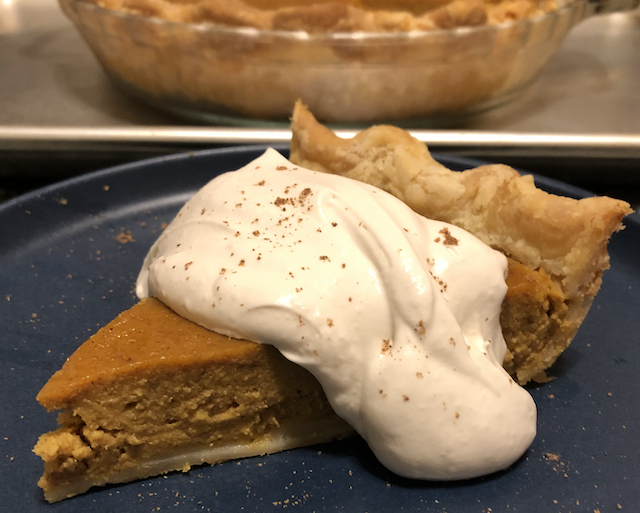 I’ve always wanted to try this exact concept out. How much flavor potential are we leaving on the table by relying on the convenience of canned goods? Even before the additional complexity of this recipe kicked off, tracking down the appropriate sugar pie pumpkins during the post-thanksgiving, pre-christmas lull was a challenge in itself. 5 grocery stores and $12 hard-earned dollars later, the pumpkins were secured and I was ready to get started. This better be worth it.
I’ve always wanted to try this exact concept out. How much flavor potential are we leaving on the table by relying on the convenience of canned goods? Even before the additional complexity of this recipe kicked off, tracking down the appropriate sugar pie pumpkins during the post-thanksgiving, pre-christmas lull was a challenge in itself. 5 grocery stores and $12 hard-earned dollars later, the pumpkins were secured and I was ready to get started. This better be worth it.
Recipe Tweaks vs. Control
- Replace canned pumpkin puree with DIY roasted pumpkin
- Replace evaporated milk with homemade caremelized milk
Ratings I’m glad I tried this, if only to learn I don’t need to do it again. The process of cleaning, roasting, and pureeing pumpkins at home takes quite a while and makes a huge mess, but the output is simply a blander, waterier version of what’s readily available in the can. Just check out this side-by-side comparison of the canned pumpkin on the left, vs. home-roasted pumpkin on the right.
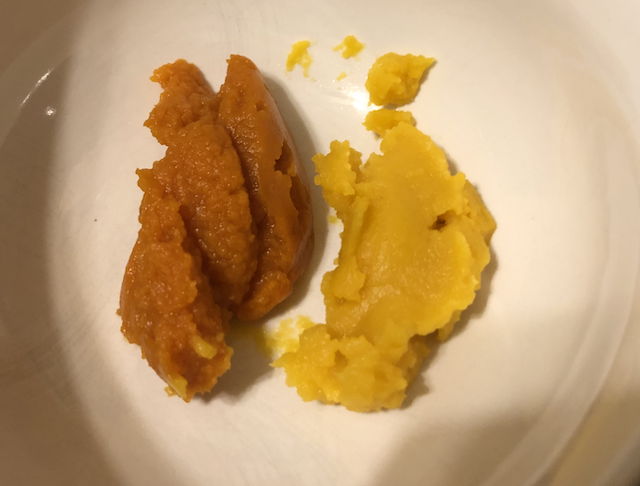
By color alone, the canned pumpkin is much more appealing, a conclusion easily verified with a taste test. The DIY evaporated milk wasn’t nearly as much of a hassle, but tastes so subtly different from the store-bought variety that I can’t help but think the extra time is spent developing bolder flavor.
Flavor: 6 - Roasting typically available pie pumpkins yields a product that’s dissapointingly blander than the canned version.
Intrigue: 8 - I’ve always wanted to make a completely from-scratch pumpkin pie. No regrets in taking on the project.
Efficiency: 4 - Pumpkin roasting ties up the oven for a while and makes for quite a bit more cleanup.
Total: 18
Ultimate Pumpkin [Butternut Squash] Pie:
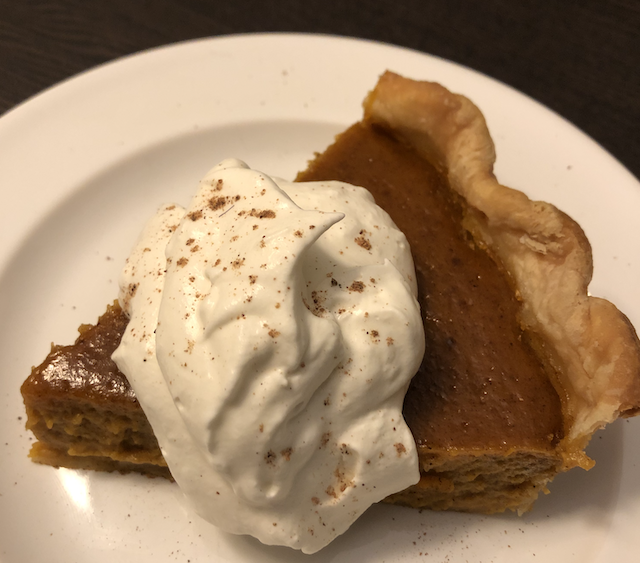
I was so bought in when I first read this recipe. As discovered in while making my own pumpkin puree for the recipe above, the pumpkins used in typical canned pumpkin puree are a different variety to what we can get in the grocery store. In fact, they more closely resemble butternut squash than the typical pie pumpkins we’re used to seeing. This makes a lot of sense - a typical pie pumpkin is full of air, so doesn’t yield much profitable, puree-able flesh for its volume - not to mention the proponderance of annoying seeds. Logically, things were looking good for this substitution to work out.
Recipe Tweaks vs. Control
- Replace 15oz can of pumpkin with 2 lbs of cubed, roasted, and pureed butternut squash
- Evaporated milk replaced with heavy cream + brown sugar
Ratings
Simply put, this didn’t work. Despite having more sugar than some other contenders, I still found this pie to have a slightly vegetal taste. It wasn’t bad, but it was sort of a gustatory uncanny valley. Like the animated characters in Polar Express, creating something 95% similar to the real deal is worse than being something completely different. The weird factor wasn’t enough to stop me from having a couple of followup slices for breakfast and lunch the next day, but ultimately this is the only pie on this list I didn’t finish.
Flavor: 5 - A well-intentioned substitution, but ultimately distracting.
Intrigue: 8 - No other recipe on this list made me think so deeply about squash biology.
Efficiency: 6 - While the DIY puree is an additional step, it’s less messy than using pumpkins and the leftover squash is useable.
Total: 19
The Fancy One
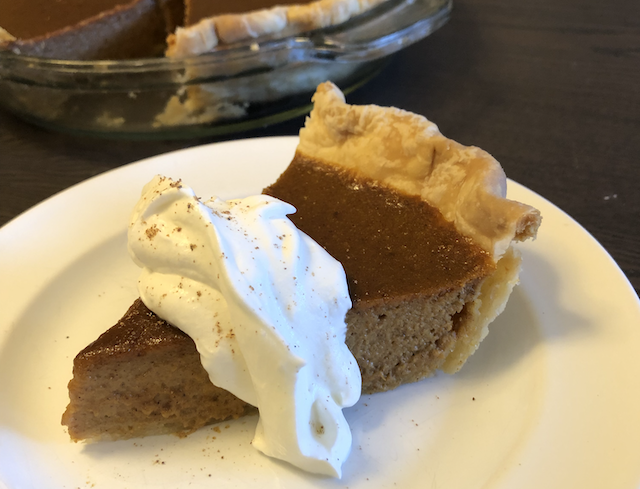 Even just looking at the video thumbnail and seeing the deep brown custard I knew this recipe was going to be a hit. Upon taking a closer look and seeing things like ‘brown butter caramelized honey’, I knew we were in for a cheffy treat. That being said, while more complex, there’s not a bit of exess bloat in this recipe. Every additional step is aimed at layering on flavor and all can be accomplished while the crust is blind baking.
Even just looking at the video thumbnail and seeing the deep brown custard I knew this recipe was going to be a hit. Upon taking a closer look and seeing things like ‘brown butter caramelized honey’, I knew we were in for a cheffy treat. That being said, while more complex, there’s not a bit of exess bloat in this recipe. Every additional step is aimed at layering on flavor and all can be accomplished while the crust is blind baking.
Recipe Tweaks vs. Control
- Replace sweetened condensed milk with heavy cream, brown sugar, and brown butter caramelized honey
- 2x heavier seasoning
- Fully blind baked crust
Ratings WOW this was good. At the risk of spoiling the conclusion, I’ve already made this again and it was just as good the second time. Just enough for a nice couple-hour activity and the final results are easily worth it. A great elevation of the classic flavors, while still remaining true to the original. You, yes you, have to make this.
Flavor: 9 - Saving some room at the top for something truly mind-blowing, but come on.
Intrigue: 8 - brown butter caramelized honey. Need I say more?
Efficiency: 6 - The additional complexity doesn’t add much in the way of total time vs. the control, but there are inarguably more dishes to clean.
Total: 23
Conclusions [Pie Charts?]
If I didn’t give it away in testing section, the Claire Saffitz recipe was an easy winner in my book. It’s a delicions take on a classic that makes the extra time spent worth it. This is borne out in the overall scores:
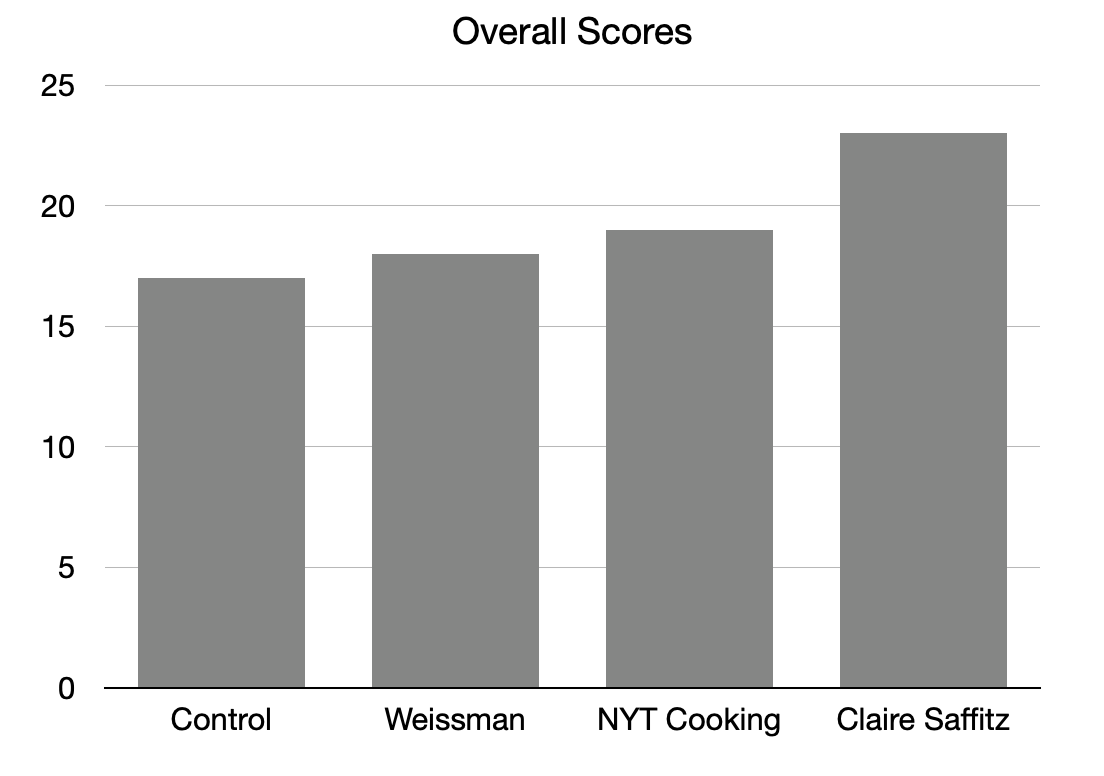
However, there’s no doubting that the Saffitz recipe has some additional workload involved. If you’re juggling a bunch of other holiday cooking tasks and simply need something to come together with minimal hands-on time, the classic recipe is no slouch in the flavor department. If we plot flavor vs. efficiency for each of these recipes, it’s easy to see that the Classic and Saffitz recipes are in a league of their own.
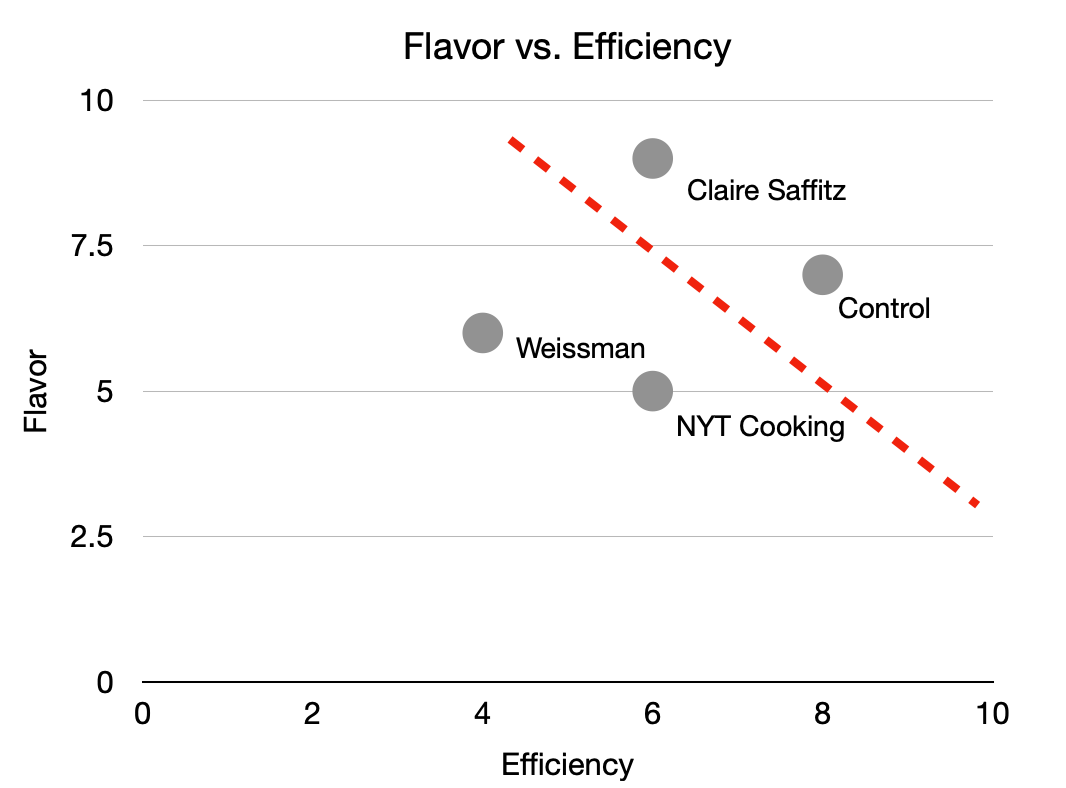 Greater distance from the origin in the above represents a ‘better’ product on these selected dimension. We can imagine a decision boundary (illustrated in red) that removes the Weissman and NYT Cooking recipes from the equation and reduces the question to a simple matter of how much capacity you have to be hands-on with the process.
Greater distance from the origin in the above represents a ‘better’ product on these selected dimension. We can imagine a decision boundary (illustrated in red) that removes the Weissman and NYT Cooking recipes from the equation and reduces the question to a simple matter of how much capacity you have to be hands-on with the process.
Purely looking at the most efficient way to get at a flavorful product isn’t the only concern in play, though. Often, I select recipes by how much value I see in them as a project. Swapping out efficiency for intrigue scores yields the following plot:
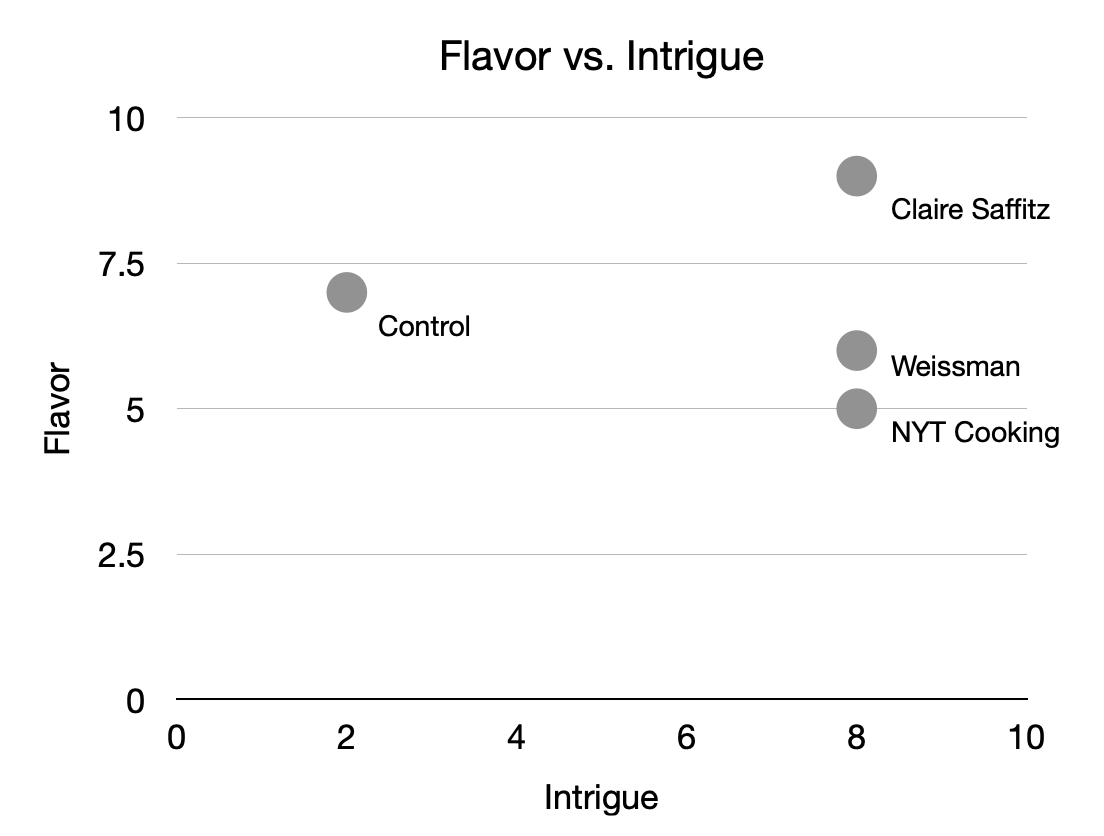
Outside of the control, each recipe carries similar intrigue scores, meaning I felt each was an equally compelling project. Between accomplishing the goal of a pie completely from scratch as provided by the Weissman recipe, taking a closer look at pumpkin varieties as prompted by the NYT Cooking recipe, and the elevated techniques used in the Saffitz recipe, each one made for a fun afternoon. That being said, the Saffitz recipe is again the clear winner and the only one that made the additional work not just a learning experience, but a key contributor to a superior product.
If you made it this far, thanks for reading. I hope you check out each of these recipes and give them a try for yourself. Check back in 2022 for another breakdown of the year’s internet pie fads.